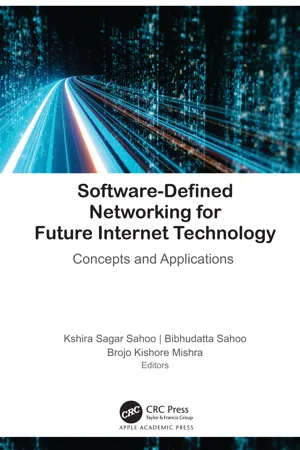
Software-Defined Networking for Future Internet Technology
Concepts and Applications
- 290 pages
- English
- ePUB (mobile friendly)
- Available on iOS & Android
Software-Defined Networking for Future Internet Technology
Concepts and Applications
About This Book
Network infrastructures are growing rapidly to meet the needs of business, but the required repolicing and reconfiguration provide challenges that need to be addressed. The software-defined network (SDN) is the future generation of Internet technology that can help meet these challenges of network management.
This book includes quantitative research, case studies, conceptual papers, model papers, review papers, and theoretical backing on SDN. This book investigates areas where SDN can help other emerging technologies deliver more efficient services, such as IoT, industrial IoT, NFV, big data, blockchain, cloud computing, and edge computing. The book demonstrates the many benefits of SDNs, such as reduced costs, ease of deployment and management, better scalability, availability, flexibility and fine-grained control of traffic, and security.
The book demonstrates the many benefits of SDN, such as reduced costs, ease of deployment and management, better scalability, availability, flexibility and fine-grained control of traffic, and security.
Chapters in the volume address:
- Design considerations for security issues and detection methods
- State-of-the-art approaches for mitigating DDos attacks using SDN
- Big data using Apache Hadoop for processing and analyzing large amounts of data
- Different tools used for attack simulation
- Network policies and policy management approaches that are widely used in the context of SDN
- Dynamic flow tables, or static flow table management
- A new four-tiered architecture that includes cloud, SDN-controller, and fog computing
- Architecture for keeping computing resources available near the industrial IoT network through edge computing
- The impact of SDN as an innovative approach for smart city development
- More.
The book will be a valuable resource for SDN researchers as well as academicians, research scholars, and students in the related areas.
Frequently asked questions
Information
CHAPTER 1 Security Issues in SDN
1Department of Electronics and Computer Engineering, Sreenidhi Institute of Science and Technology, Telangana, India
2Department of Information Technology, VNR Vignana Jyothi Institute of Engineering and Technology, Hyderabad–500090, Telangana, India, E-mail: [email protected]
3Department of Computer Science and Engineering, Sreenidhi Institute of Science and Technology, Telangana, India
1.1 INTRODUCTION TO SECURITY ISSUES OF SDN
- They are centrally controlled networks;
- They consists of open programmable interfaces;
- They use switch management protocols;
- Flexible for third party network services;
- They are also known to be the virtualized local networks;
- They consist of centralized monitoring units.
1.1.1 SOFTWARE-DEFINED MOBILE NETWORKS (SDMN)
Table of contents
- Cover
- Half Title
- Title Page
- Copyright Page
- Table of Contents
- Contributors
- Abbreviations
- Preface
- 1. Security Issues in SDN
- 2. Distributed Denial of Service Attacks in SDN Context
- 3. Policy Management in Software-Defined Networks
- 4. Flow Table Scalability in Software-Defined Networking: A Brief Overview.
- 5. Micro-Service Provisioning in the Multi-Tier SDN-Fog Architecture for IoT Applications.
- 6. Blockchain-Supported Cloud Architecture for Software-Defined Industrial IoT.
- 7. DDoS Attack Detection in Software-Defined IoT: A Big Picture
- 8. SDN-Enabled Fog Computing Architecture
- 9. Software-Defined Industrial IoT for Smart City Applications
- 10. Software-Defined Network and Network Function Virtualization: A Comparative Study.
- Index